Storage buildings
8 tips to keep the temperature stable in your storage building
8 min reading time
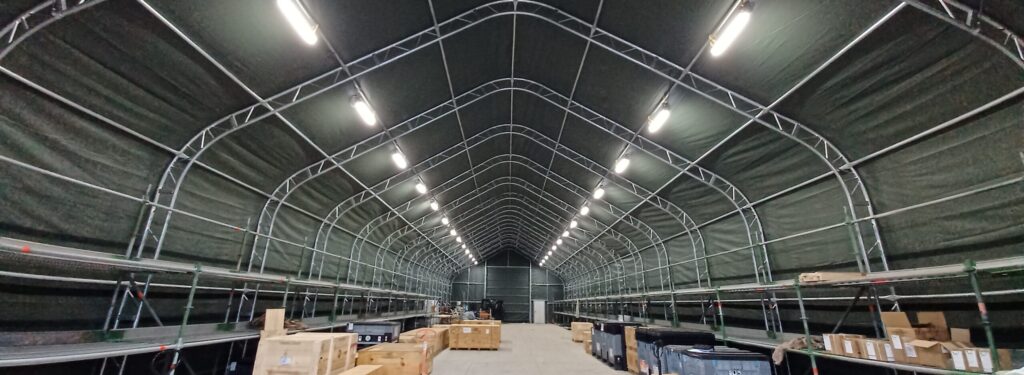
You know you need storage space and that there are different options, such as a self-build storage building, a warehouse tent, and a storage tent. At Kroftman, we have been developing and selling affordable storage solutions for business storage, including storage buildings and tents, for over 15 years. So, what suits you best? Below is a quick comparison of these three options on 14 points. In this blog, we will also address:
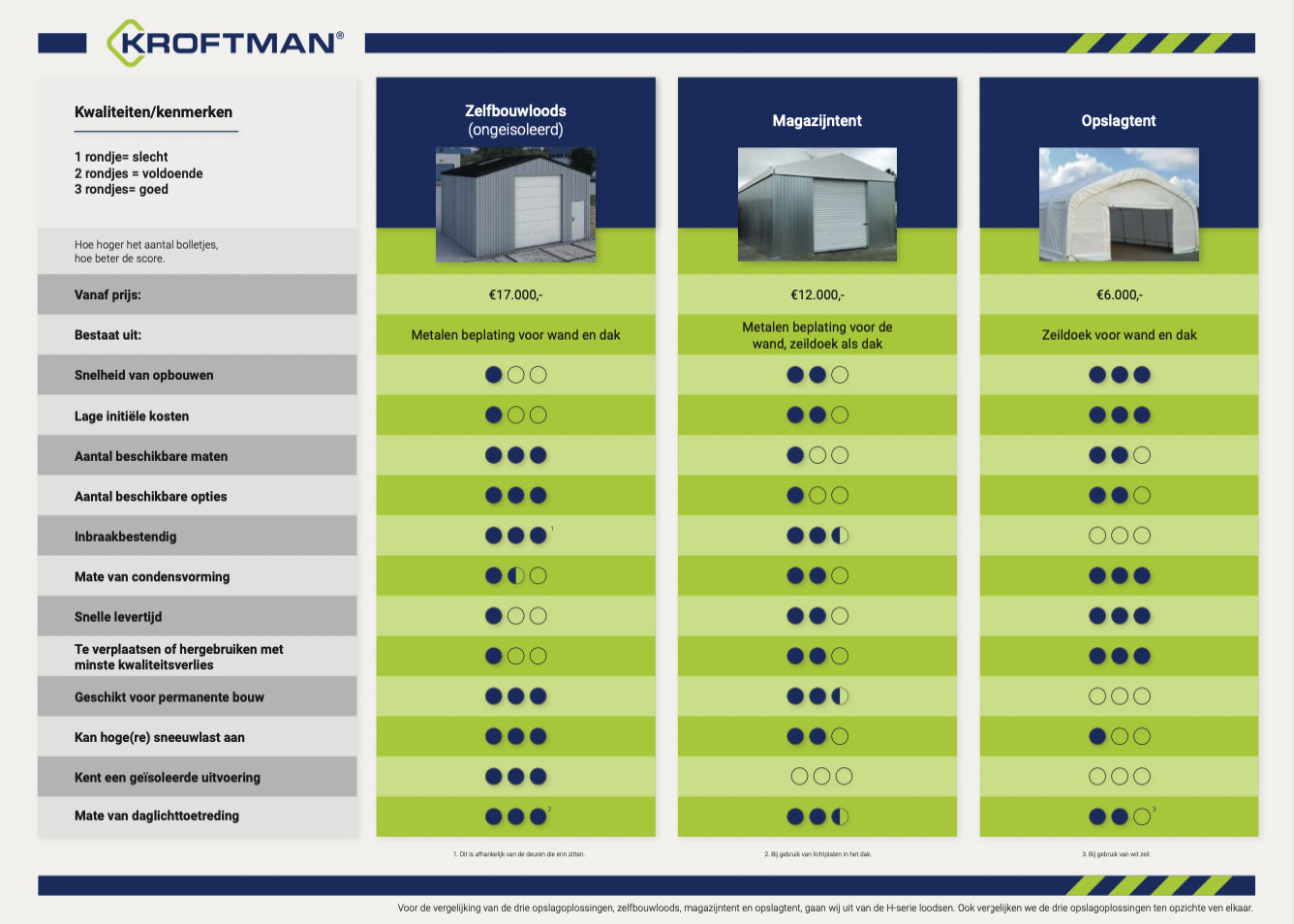
Based on the above scheme, we cannot say which of the three storage solutions is 'the best'. They all have both advantages and disadvantages when compared to each other. Below, we will further elaborate on what those advantages and disadvantages are.
Before we delve into the three storage solutions, we would like to briefly discuss the two different types of self-build storage buildings that we sell at Kroftman. We have the E-series sheds and the H-series sheds. The E-series sheds are very competitively priced, and therefore cheaper than a warehouse tent. You can already get an E-series shed from €10,500. These are the smaller storage buildings that we purchase in their entirety and in large quantities, and do not produce ourselves. You cannot make any changes to the storage building. It comes standard with a walk-in door and a roller door. The only options we offer for the E-series storage buildings are:
Our self-build storage buildings are standardized storage buildings consisting of a structure of metal C-profiles, clad with sheet metal, also made of metal. A major advantage of our self-build storage buildings, compared to tent solutions, are the choices we offer in length and width dimensions. We have storage buildings ranging from approximately 52 m² (150 m³) to 500 m² (2000 m³). The different types of storage buildings each have their own minimum and maximum width and height dimensions.
In addition to a wide choice of dimensions, with a self-build storage building you also have the widest range of extra options compared to tent versions. This includes moving doors, adding extra doors, including an electric motor if desired. For the sheet metal, you can choose from many colors for non-insulated storage buildings. Extra skylights in the roof are possible, as well as adding gutters and downpipes.
An insulated self-build storage building has the least condensation of the three storage solutions. Condensation occurs at high humidity. The (warm) air cools against the colder parts of a storage building, such as the wall and roof panels and the floor, causing the water vapor in the air to condense. These surfaces of the storage building become moist and water droplets form. If the droplets on the ceiling become too large and therefore too heavy, they fall down.
To prevent damage from falling water droplets in an uninsulated storage building, we use Dripstop®. Dripstop is a layer of felt that is standardly applied to the underside of the solid roof panels of our uninsulated H-series storage building. The Dripstop felt layer absorbs the condensation. As soon as the outside temperature rises, the moisture evaporates again. This prevents condensation from dripping off the roof cladding and damaging the stored products or machinery.
In an insulated storage building, you will have less trouble with condensation. Due to the insulation of the roof and wall panels of an insulated storage building, the surfaces are less cold and condensation will occur in fewer places. If you want to store items as dry as possible and with the least temperature fluctuations, then an insulated storage building is the best option.
A self-build storage building can also have the highest snow load. Not surprising, since the roof consists of metal panels and polycarbonate skylights. In a warehouse tent and storage tent, the roof is made of tent fabric. There should not be too much snow on it, otherwise, the fabric may tear.
Last but not least, the self-build storage building is the most suitable storage form for permanent construction.

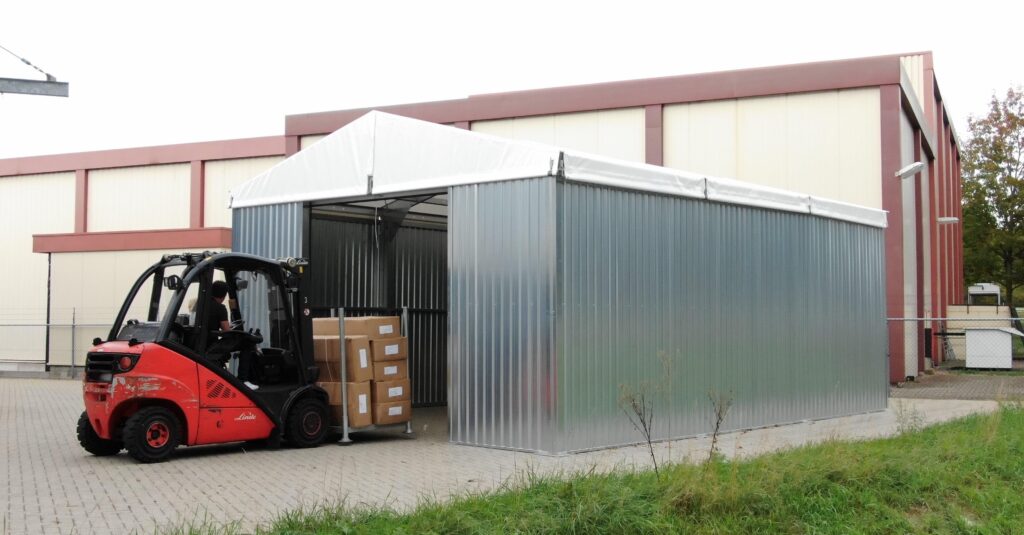
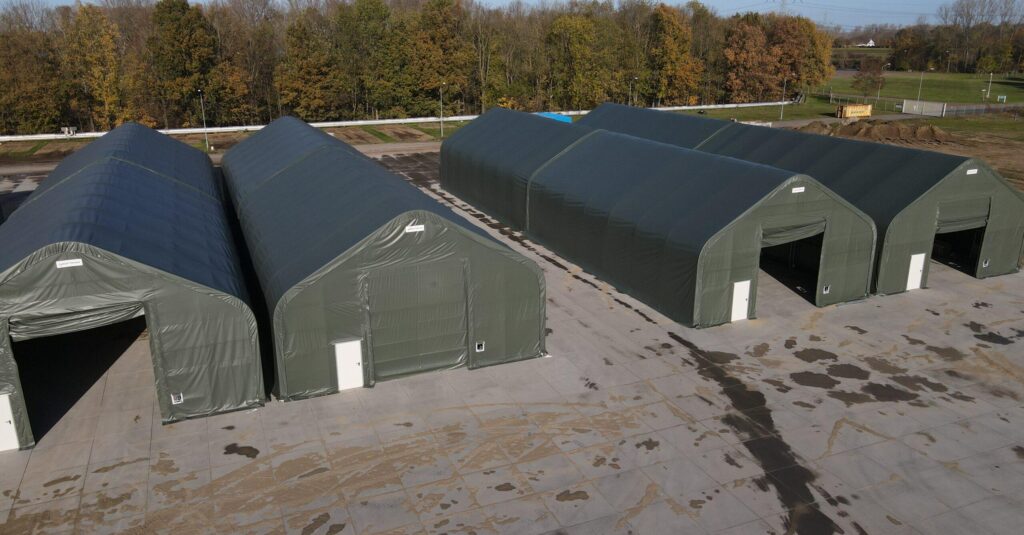
The self-build storage buildings also has some disadvantages compared to tent solutions. The acquisition costs are higher, especially if you opt for an insulated storage building. For a storage building to be placed correctly, a flat surface is very important. For the best result, we advise placing a storage building on a concrete foundation. However, this incurs costs. These are categorized as preparation costs. Applying for a building permit also falls under the preparation costs. In most cases, especially if you opt for permanent construction, you will need to apply for a building permit. You can quickly check whether a building permit is required on the environment portal.
Our self-build storage building consists of all separate parts. We produce structural parts ourselves and purchase other parts from various suppliers. For the products we make ourselves, we purchase the raw materials. We have parts in stock but for some parts, we are also dependent on the delivery time of our suppliers. Once you have met the payment obligation, we start production of the storage building. Because we want to deliver a complete storage building to you, and in one transport, we collect all parts for your storage building until it is complete. The lead time or delivery time depends on the type of storage building you have ordered. For smaller and non-insulated storage buildings, this is usually 6 to 8 weeks after payment. For insulated and larger storage buildings, it is advisable to allow for a delivery time of 12 to 14 weeks after payment. Of all three storage solutions, a storage building has the longest delivery time. Warehouse tents have a delivery time of 4 to 6 weeks. Storage tents can often be delivered from stock.
The assembly of a storage building takes longer than the assembly of a warehouse or storage tent and is also more complex. Especially assembling an overhead door requires specialist knowledge. If you hire a company to assemble the storage building for you, the assembly costs for a storage building are higher than those for assembling a warehouse or storage tent.
In principle, a self-build storage building is not suitable for relocation or reuse. Once the storage building is in place, we advise against dismantling it and rebuilding it elsewhere. It can be done, but it does not improve the quality.
Our warehouse tent is a combination of a storage building and a storage tent. The structure consists of cold-rolled steel C-profiles and walls made of non-insulating corrugated metal panels, just like our uninsulated self-build storage buildings. For the roof, we do not use metal panels but PVC tarpaulin. This makes the warehouse tent as strong and burglary-resistant as an uninsulated storage building with a roller door and as easy to dismantle and light as a storage tent.
The acquisition costs of a warehouse tent are slightly lower than those of our H-series storage buildings (the E-series storage building are an exception) and slightly higher than those of a storage tent.
The assembly time of a warehouse tent is shorter than that of a storage building. Also, we can deliver a warehouse tent faster than a storage building. The average delivery time is four to six weeks. Compared to a steel storage building, the warehouse tent can be dismantled very quickly and almost damage-free. This makes it possible to move the warehouse tent several times or resell it with a high residual value.
The construction of the warehouse tent can withstand a snow load of up to 130 kg of snow per square meter. This means that the tent is suitable for a permanent building permit in practically the whole of Europe. Keep in mind that the snow load is based on the construction of the warehouse tent. The roof consists of tent fabric and it is best to keep it as snow-free as possible. The daylight penetration is good because the white PVC tarpaulin allows a lot of light to enter. In image 4 you can see a photo of the inside of a warehouse tent.
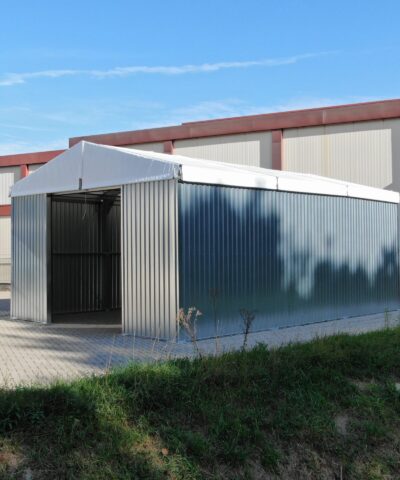
With a warehouse tent, you have fewer options in sizes compared to a storage building or storage tent. Our warehouse tent is always six meters wide. You can easily extend the warehouse tent by (a multiple of) 2.86 meters. You can choose the type of anchoring, ground pegs for any type of hard surface or concrete anchors if you place the storage building on concrete (plates). There is also the option of an additional roller door in the rear wall. We do not offer more options for a warehouse tent. Each warehouse tent has the color scheme you see in the above photo. The glossy color will become duller over the years, but this does not affect the quality.
In a warehouse tent, you will experience more condensation than in a storage building. A tent fabric cannot have a Dripstop felt layer like an uninsulated storage building. If you want to store vulnerable products that are less resistant to moisture or temperature fluctuations, then an insulated storage building is a better option.
A storage tent consists of a structure of round, galvanized steel pipes with a PVC or HDPE tarpaulin over it. The PVC tarpaulin is stronger than HDPE and is therefore better resistant to weather influences. The lifespan of PVC is longer. We offer a declining warranty period of 10 years for PVC, and 3 years for HDPE. The biggest advantage of a storage tent is that it is cheap to purchase and easy to assemble yourself. The ground does not need to meet such high requirements as for a storage building. The reason for this is that the cladding consists of tarpaulin. Unlike metal cladding, tarpaulin gives way and does not gap. You will receive a complete construction kit, including extensive manual and construction drawings. This allows you to quickly and without high assembly costs build your storage tent yourself. Also, like a warehouse tent, a storage tent is easy to dismantle and rebuild without compromising quality, as with a storage building.
Our storage tents have more options in width sizes than our warehouse tents. You can choose from four different width sizes (5.5 meters, 7.9 meters, 9.2 meters, and 12.2 meters). For each width size, there is a standard length size. Sometimes you can choose from two length sizes. For the length, we have a total of five different options, from 12 meters to a maximum of 25 meters. The width size determines which of these five length options are possible. Other options you can choose from are:
Another great advantage of a storage tent is the short delivery time. We have storage tents in stock in our warehouse. If you are able to pick up the storage tent yourself, for example with a trailer, you can pay for and take your storage tent with you directly from us.
A storage tent is a tent. This cannot be insulated and is sensitive to temperature fluctuations. This means that condensation will always occur. Another disadvantage is susceptibility to burglary. A tent fabric is easy to cut open. Consider carefully in advance what you want to store. If these are items that can tolerate some condensation and temperature fluctuations, and are not desirable to thieves, then a storage tent may be the right choice for you.
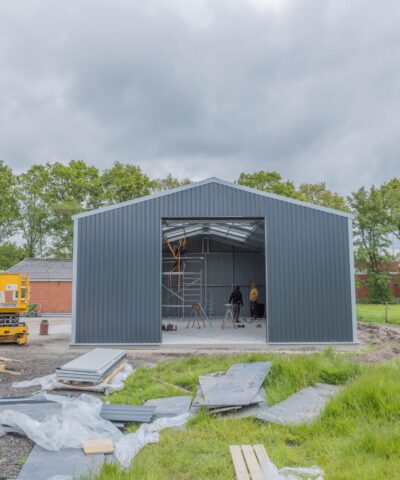
Our storage tents have the lowest snow load of all three storage solutions. Depending on the model, they have a snow load of up to 0.50 kN/m2 and can withstand wind forces of up to 10 Bft. You can request the structural calculations from us free of charge. If necessary, the storage tent can also be erected in areas with a higher snow load, provided that it can be ensured that the limit of 50 kg/m² is not exceeded. For example, by heating the tent in winter and keeping the roof snow-free.
With green PVC tarpaulin storage tents, daylight penetration is limited. Of course, you can install electricity (or have it installed) and install lamps yourself. Also, keep in mind that some storage tents have round side walls. If you want to place shelves on the sides of the tent, it is better to choose a different model (T5 or T12) or a warehouse tent. Also, a storage tent is not suitable for permanent construction in principle. They are often used for a temporary solution or if extra storage is only needed in a certain season. Then a storage tent is ideal. After use, you can store the tent and set it up again the following year.
That was a lot of information. Which storage solution is best for you now? Below is a brief summary.
A self-build storage building is suitable for people who:
A warehouse tent is suitable for people who:
A storage tent is suitable for people who: